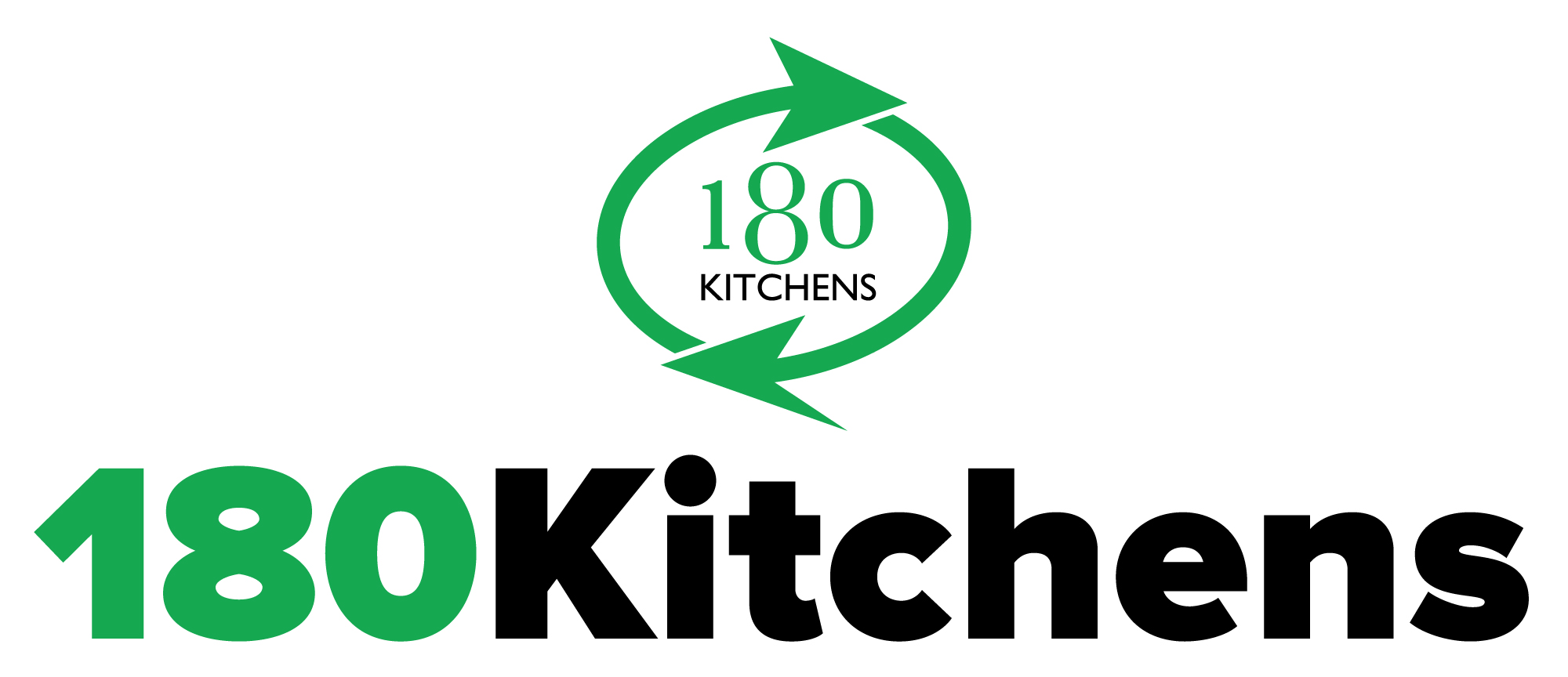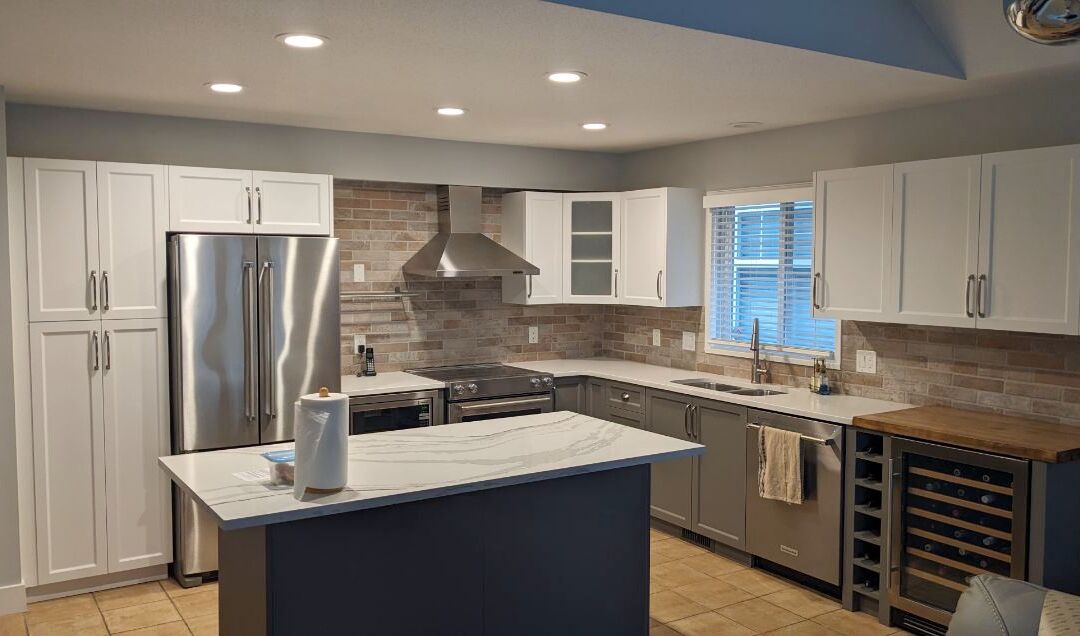Kitchen remodeling can be a lengthy and expensive affair. But, as a homeowner, you always seek ways to revamp your space without breaking the bank. One such method is cabinet refacing, a cost-effective and eco-friendly solution to giving your kitchen a fresh, new look. In this blog, we will delve into the reasons why you should consider cabinet refacing before gutting your kitchen.
What is Cabinet Refacing?
Cabinet refacing is a technique that involves replacing existing cabinet doors, drawer fronts and end panels with new ones. This process results in a significant transformation of your kitchen’s appearance, without the need to entirely replace your existing cabinets.
The focus remains on the external appearance, leaving the internal structure or ‘shell’ of the cabinets untouched. This is why it’s crucial that your existing cabinet shells are in good condition – free from stains, warping, damage, and other defects. The good news is, if you have a few cabinet boxes that are in rough shape – those individual boxes can be replaced.
Why Should You Consider Cabinet Refacing?
Less Expensive:
Cabinet refacing is a cost-effective alternative to a full cabinet replacement. When you choose cabinet refacing, you can retain the existing cabinet boxes while giving them a fresh look. This process typically involves replacing the cabinet doors, drawer fronts, and end panels. By preserving the structural elements of your cabinets, you save a significant amount of money compared to buying entirely new cabinetry.
Cabinet refacing is particularly advantageous if your cabinet boxes are still in good condition, and you’re satisfied with the current layout. It’s an economical way to achieve a kitchen transformation without the high cost of a complete remodel.
Quicker:
Time is of the essence when it comes to home improvement projects. Cabinet refacing is a much faster process compared to a full cabinet replacement. Refacing typically takes a fraction of the time that a complete cabinet replacement requires.
With cabinet refacing, there’s no need to dismantle and remove the existing cabinets. This means less disruption to your daily routine, and you can start enjoying your newly refaced cabinets sooner. The quicker turnaround time is a significant advantage, especially for those who want to update their kitchen without enduring long construction periods.
New Look, Feel, Product, Hinges, Hardware:
One of the primary benefits of cabinet refacing is the opportunity to achieve a brand-new appearance and functionality for your cabinets. During the refacing process, you can choose from a wide variety of door styles, finishes, and materials. This allows you to customize the look and feel of your cabinets to match your desired aesthetic.
In addition to aesthetic changes, cabinet refacing also allows for the replacement of worn-out or outdated hinges and hardware. You can upgrade to modern, durable, and stylish hardware that not only enhances the appearance but also improves the functionality of your cabinets.
Keeps Cabinets Out of the Landfill:
Cabinet refacing is an environmentally friendly option because it reduces waste and minimizes the environmental impact. By reusing the existing cabinet boxes and updating their appearance, you contribute to sustainability by keeping cabinets out of landfills. This practice aligns with eco-friendly principles, making cabinet refacing a responsible choice for those who want to renovate their kitchens with a focus on reducing waste and conserving resources.
When is Cabinet Refacing The Right Option?
Cabinet refacing is a great option when:
- Your existing cabinet shells are in great condition
- You plan to maintain the same kitchen layout
- Only some of your cabinets need replacement.
Before considering cabinet refacing, it is crucial to assess the condition of your kitchen cabinets. The shells of the cabinets should be in good condition, free from stains, warping, broken frames, peeling, and other damage. The shelves inside the cabinets should be level, flat, and not bulging or sagging. If your cabinets meet these criteria, refacing can be a viable and cost-effective option. The good news is the ones that are in poor condition – we can replace!
As part of the free in-home estimate with 180 Kitchens – we will determine whether your cabinets are suitable for refacing, and carefully inspect the interior of the cabinet shell. Look for any visible damage or structural issues that may require replacement of the cabinet boxes.
The Colour Factor
Another factor to consider is the colour of your new kitchen cabinets. If your existing cabinets are in good condition and already match the desired colour, refacing can be an excellent choice. By replacing only, the exterior parts of your kitchen, you can achieve a cohesive and consistent aesthetic without the need for a complete overhaul.
It is also important to evaluate whether the existing layout of your kitchen meets your needs. If you are satisfied with the current arrangement and functionality, refacing can be a suitable option. However, if you desire significant layout changes, such as relocating the sink or stove, refacing may not be the best solution.
Furthermore, if you have specific storage requirements, such as the need for pot drawers or a lazy susan in place of a blind corner, new cabinet carcasses may be necessary. Refacing is most effective when the existing kitchen layout remains unchanged.
Changing Some, Not All Cabinets
While some homeowners may consider replacing only a few cabinets, it is essential to carefully weigh the pros and cons. If your cabinets are more than 20 years old, it may not be worth refacing. Modern cabinets are manufactured differently, and a mismatch between new and old cabinets can be noticeable.
For instance, if you replace only a couple of cabinets and leave the rest untouched, the contrast in appearance can be stark. Opening the doors to reveal a mix of old and new cabinets may undermine the overall aesthetic of your kitchen. Additionally, inconsistencies in the installation process, such as when installing countertops, can further highlight the differences between old and new cabinets.
While replacing upper cabinets generally presents fewer challenges, it is advisable to consult with your contractor before deciding to replace only a few base cabinets. They can provide valuable insights based on their expertise and experience, helping you make an informed decision.
The Cost Savings of Cabinet Refacing
One of the most significant advantages of cabinet refacing is the cost savings. On average, refacing kitchen cabinets can save you between 30% to 40% compared to the cost of installing entirely new cabinets. When you consider the price range of $15,000 to $30,000 for new cabinets, the savings can be substantial.
By choosing to reface your cabinets, you can allocate more of your budget to other aspects of your kitchen renovation, such as countertops, appliances, or flooring. This cost-effective option allows you to achieve a refreshed look without compromising on quality or style.
Pros of Kitchen Cabinet Refacing
1. Cost-effective Option
Refacing your kitchen cabinets is a more affordable alternative to completely replacing them. By reusing the existing cabinet shells and focusing on updating the doors, drawer fronts, and panels you can achieve a new look at a fraction of the cost.
2. Eco-friendly Solution
Opting for cabinet refacing contributes to sustainability by reducing waste. By keeping the existing cabinet boxes and avoiding the need for new ones, you help minimize the environmental impact associated with manufacturing and disposing of old cabinets.
3. Style Options Galore
When it comes to door styles, the options are virtually limitless. With cabinet refacing, you can choose any style available, just as you would in a full kitchen renovation. Whether you prefer a traditional, modern, or transitional look, you can find the perfect door style to match your aesthetic preferences.
4. Time-efficient Process
Compared to a complete kitchen renovation, cabinet refacing takes significantly less time to complete. Since there is no need for extensive demolition or installation of new cabinets, the project can be finished in a fraction of the time, allowing you to enjoy your revamped kitchen sooner.
5. Minimal Disruption
During the cabinet refacing process, you can still use your kitchen. Unlike a full renovation, where the kitchen may be out of commission for an extended period, refacing allows you to maintain your regular cooking and meal preparation routines.
Cons of Kitchen Cabinet Refacing
1. Unsuitable Cabinets
Not all cabinets are suitable for refacing. If your cabinets are stained, damaged, warped, or in poor condition overall, refacing may not be a viable option. In such cases, it is advisable to explore other alternatives, such as cabinet replacement or a complete kitchen renovation.
2. Challenging Installation
While replacing door and drawer fronts is relatively straightforward, the vinyl application in certain areas can be a more complex task. It requires specific skills and techniques, making it less suitable as a DIY project. To ensure a professional and flawless finish, it is recommended to entrust the installation to experienced contractors.
3. Cosmetic Renovation Only
Cabinet refacing is a cosmetic solution aimed at improving the appearance of your kitchen cabinets. If you are looking to enhance the functionality or storage capacity of your cabinets, refacing alone will not address these concerns. In such cases, it may be necessary to consider additional modifications, such as retrofitting drawers or adding new cabinets, which is available with 180 Kitchens.
4. Limited Storage Improvement
If your existing kitchen already lacks sufficient storage space, cabinet refacing will not alleviate this issue. Refacing primarily focuses on the exterior appearance of the cabinets and does not expand or reconfigure the storage capacity. If storage is a significant concern, you may need to explore alternative options, such as installing additional cabinets or reorganizing the existing space.
Is Cabinet Refacing Worth It?
In summary, cabinet refacing offers a cost-effective and eco-friendly solution for transforming the look of your kitchen. It is a suitable option when your existing cabinets are in good condition, the desired colour scheme can be achieved with minimal changes, and the current layout meets your needs.
By refacing your cabinets, you can enjoy significant cost savings compared to a full cabinet replacement. The process is relatively quick and allows you to continue using your kitchen throughout the renovation. Additionally, the wide range of style options ensures that you can create a kitchen that reflects your personal taste and design preferences.
Check out our comprehensive article on the topic: “Is Cabinet Refacing Still Worth It?”
However, it is important to note that refacing is a cosmetic renovation and does not address functional or storage concerns. If your cabinets are in poor condition, require significant layout changes, or lack sufficient storage, alternative options may be more suitable for your needs. Ask 180 Kitchens about their Hybrid Kitchen option – this may be right for you!
To make an informed decision and explore the possibilities of cabinet refacing, it is advisable to consult with a reputable contractor. They can assess the condition of your cabinets, provide expert recommendations, and guide you through the process to achieve the kitchen of your dreams.
If you are considering cabinet refacing in the Vancouver or Edmonton area, look no further than 180 Kitchens. Our team of experienced professionals specializes in kitchen renovations and can help you transform your space with high-quality cabinet refacing. Contact us today for a free, no-obligation quote and consultation.
In conclusion, cabinet refacing is a cost-effective, quick, and eco-friendly way to give your kitchen a new look. It is an option worth considering before gutting your kitchen entirely. Invest wisely, choose refacing, and transform your kitchen into a space you love.


Recent Comments